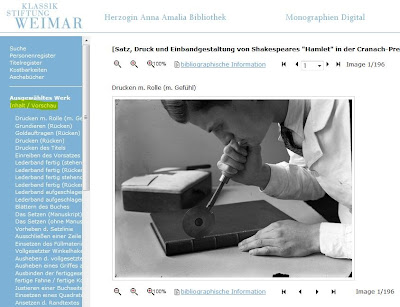As often happens when reading, one finds a source mentioned, follows it to something else, and off one goes. This was the case for me recently. While researching a mention of Ernst Collin I came across an advertisement for a journal associated with a center-left political party among the names mentioned was an Ernst Collin, but also many other leading figures of the arts, civic organizations, politics, ... Also among the names was
Harry Graf Kessler, an Anglo-German count, diplomat, writer, and patron of modern art who in 1903 became Director of the the "Museum für Kunst und Kunstgewerbe" (Arts and Crafts) in Weimar, founding the Deutsche Künstlerbund (German Federation of Artists - a very avant garde group) in the same year.
Berlin in Lights, The Diaries of Count Harry Kessler (1918-1937) was reviewed in the
New York Times in 2000 by Iain Bamforth, with the review entitled "
Present at the Destruction" providing a good introduction to the man and the times.
In 1913, Kessler founded the Cranach Press in the spirit of the Arts and Crafts movement and inspired by the likes of William Morris, the Doves Press, Cobden Sanderson, and others to publish livre d'artistes. Among those he worked with were
Eric Gill,
Henry van der Velde,
Aristide Maillol and
Edward Gordon Craig . It was the latter who illustrated the Cranach Press'
Hamlet in 1928. Sarah Werner in her
Wynken de Worde blog has a good illustrated description of the
Hamlet.
The
Herzogin Anna Amalia Bibliothek in Weimar is celebrating the 100th anniversary of the Press and issued a wonderful catalog that provides background information on Kessler, his activities in Weimar, with the remainder given over to the depicting works Kessler published, including job work. The bulk of the illustrations are dedicated to the livre d'artiste however.
Also included in the catalog is a poster depicting the process of creating
Hamlet, including layout, preparing the paper, proofing, printing and not enough of the binding process by Otto Dorfner (below). Dorfner was also associated with the Bauhaus in Weimar, was a founding member of
Meister der Einbandkunst, but also was on the Nazi's
Gottbegnadeten List or artists crucial to the Nazi's culture. He created among other things presentation bindings and objects).
 |
"Professor Otto Dorfner surrounded by his students"
Note the master in his white lab coat (kittel) surrounded by his focused students critiquing work.
From: Weisse, Franz. "Prof Otto Dorfner 25 Jahre Fachlehrer."
Der Buchbinderlehrling, Vol 9, Nr 2, 1935 |
Back to the poster with images of the printing process. Those fortunately are online in the
Herzogin Anna Amalia Bibliothek's digital collections. While the poster only has 60 images, the online collection has 96 (still few of the binding process).
The collection can be accessed here. Presentation could be better, the images are not really in order of process, and scans from glass plate negatives are interspersed with scans of the envelopes (containing descriptive information). Still a good resource. Navigation (in German only) below. At left, highlighted in the blue panel, Inhalt gives the list of images that will appear at right, Vorschau provides thumbnails of the images. You can also scroll through using the arrows above the images...
 |
| Click to enlarge |
The catalog to the exhibit can be ordered online from
Amazon. It's in German only, but has lots of pictures.
See also:
Is this really a prospectus for the Cranach Press' edition of *Hamlet*, or
a (later) facsimile of one? It's printed on a beautiful cream laid sheet,
no watermark. The last page appears, to my high school German, to be a
description of the different states in the edition ("eight copies on
vellum/parchment...") with prices in Marks. A small addendum at the bottom
of that last page tells us the piece is a "keepsake supplied by Gallery 303
to the participants of the Heritage Series."














